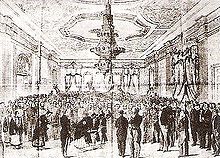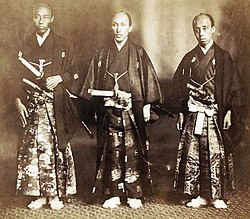Japanese legation to the United States 1860
The first Japanese embassy to the United States ( Japanese 万 延 元年 遣 米 使節 Man'en gannen kenbei shisetsu , roughly: American mission in the first year of the Man'en era) took place in 1860 under the Tokugawa shogunate, through which Japan wanted to deepen his foreign relations with the United States . The purpose of the diplomatic mission was the ratification of the Harris Treaty of 1858 and the first diplomatic visit to the United States since Japan's involuntary opening of the country by the American Navy in 1854 and the Treaty of Kanagawa negotiated in this context . On this occasion, Japan sent the warship Kanrin Maru as escort for the delegation, not least to demonstrate how profoundly the country had adopted and adapted Western navigation and ship technologies only six years after the end of its self-imposed, almost 250-year isolation. In preparation for this, the first naval exercises were held in Nagasaki as early as 1855 .
background
On January 19, 1860, the Kanrin Maru laid off in Uraga ( Yokosuka ) with a course in San Francisco under Captain Katsu Kaishu , with Nakahama "John" Manjiro as the official interpreter, 96 Japanese and the American officer John Mercer Brooke on board. Admiral Kimura Yoshitake ( 木村 喜 毅 ), a high-ranking shogunate official, was chosen as head of the mission . The future reformer and educator Fukuzawa Yukichi , then a young man full of adventure and curiosity about foreign countries, volunteered as an assistant to Admiral Kimura. The Japanese delegation itself traveled on the US ship USS Powhatan and was escorted by the Kanrin Maru - although the latter eventually took a slightly different route across the Pacific and arrived before the Powhatan . Formally, the embassy consisted of the three diplomats Ambassador Shinmi Masaoki ( 新 見 正 興 ), Vice Ambassador Muragaki Norimasa ( 村 垣 範 正 ) and observer Oguri Tadamasa ( 小 栗 忠順 ).
Destinations
San Francisco
The Kanrin Maru reached San Francisco directly and first, since the Powhatan and the embassy first made a stay in Hawaii . After arriving, the delegation stayed for a month and Fukuzawa had a picture taken of himself with an American, which became one of the most famous recordings in the Japanese history of this trip. At that time, Fukuzawa also acquired an edition of the English-Chinese Webster's Dictionary and began to learn English from it and subsequently to create his own Japanese-English dictionary based on it.
Washington DC, New York and the return trip


After the Kanrin Maru set course for Japan again, the Powhatan traveled with her staff to Panama , where the passengers crossed the isthmus using the recently opened Panama Railway. Upon arrival, they transferred to the USS Roanoke and continued the journey to Washington, DC as a 72-strong diplomatic staff . A number of receptions and obeisances were held there, including an audience in the White House with then President James Buchanan. He presented the diplomats with a gold watch with his engraved profile as a gift to the Shogun . The ambassadors then traveled north to Philadelphia . The celebrations prepared there quickly diverted their attention to the events in their homeland, which later became known as the Sakuradamon incident in Tokyo in 1860. The Tairō Ii Naosuke , a regent of the shogunate, was murdered on March 24th and the news of the deed quickly spread to the American continent by Pony Express . Ii Naosuke was the senior signer of the Harris Treaty of 1858 at the time.
The diplomats continued their journey to New York City , where they accompanied a large parade from the Battery to Broadway . From New York they then crossed the Atlantic and Indian Oceans on board the USS Niagara and thus circled the world. After leaving New York on June 30, the Niagara reached the port of Porto Grande on Cape Verde on July 16. Other stops on the way home included São Paulo-de-Loande (now Luanda ), Angola , Batavia (now Jakarta ), Java, and Hong Kong . The frigate finally sailed into Tokyo Bay on November 8, thus ending the journey of its passengers.
Effects
The Kanrin Maru's voyage from Uraga to San Francisco is often treated as the first Pacific crossing by a purely Japanese crew on a Japanese ship, even though the crew was advised by John Brooke. In fact, at least three such crossings were made as early as the 17th century before Japan isolated itself, namely by Tanaka Shōsuke in 1610, Hasekura Tsunenaga in 1614, and Yokozawa Shōgen in 1616.
literature
- Shin Jinbutsu Ōrai-sha (ed.): Bakumatsu - Meiji Furushashinchō Aizōhan ( 幕末 ・ 明治 古 写真 帖 愛 蔵 版 , "Album of old photographs of the Bakumatsu and Meiji periods : lovers edition"). Tokyo 2003, ISBN 4-404-03112-2 .
- Shin Jinbutsu Ōrai-sha (ed.): Sekai o Mita Bakumatsu-Ishin no Eiyūtachi ( 世界 を 見 た 幕末 維新 の 英雄 た ち , "Heroes of the Bakumatsu Period and Meiji Restoration who saw the world"). Tokyo 2007, ISBN 978-4-404-03364-2 .
- Tom Marshall, Sidney Marshall: The Tycoon's Ambassadors: Captain DuPont and the Japanese Embassy of 1860 . Green Forest Press, 2015, ISBN 978-0-692-38241-7 .
Web links
- JapanDayNYC 2010
- Arrival of the first Japanese embassy (1860) ghostsofdc.org
- Relics of the 1860 legation in the Smithsonian Museum. collections.si.edu
Individual evidence
- ↑ Bakumatsu - Meiji Furushashin Chō Aizōhan. P. 20.
- ↑ Sekai wo Mita Bakumatsu-Ishin no Eiyūtachi. P. 42.
- ↑ Bakumatsu - Meiji Furushashin Chō Aizōhan. P. 21.
- ↑ Sekai wo Mita Bakumatsu-Ishin no Eiyūtachi. Pp. 30-49.
- ↑ Bakumatsu - Meiji Furushashin Chō Aizōhan. P. 21.
- ^ The Japanese in America . In: New York Times . May 10, 1860.
- ↑ Bakumatsu - Meiji Furushashin Chō Aizōhan. P. 23.
- ↑ "The Japanese in Philadelphia" . In: New York Times. June 12, 1860.
- ^ Louis Cullen: A History of Japan, 1582-1941 . 2003, pp. 180-186.
- ^ "Reception of the Japanese" . In: New York Times. June 16, 1860.
- ↑ Bakumatsu - Meiji Furushashin Chō Aizōhan. P. 21.
- ↑ "The Japanese Embassy" . In: New York Times. August 20, 1860.



